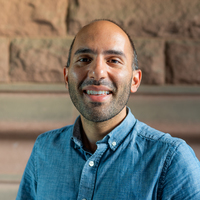Dean Chahim
New York University, Environmental Studies, Faculty Member
- Political Ecology, Political Ecology (Anthropology), Critical international political economy, STS (Anthropology), Engineering Education, Engineering and Social Justice, and 21 moreCritical Geography, Critical Development Studies, Globalization, Hydropolitics, Climate Justice, Science and Technology Studies, Actor Network Theory, Mexico City, Urbanism, Mexico (Anthropology), Sustainable Water Resources Management, Urban Geography, Urban Ecology, Neoliberalism, Infrastructure, Environmental History, Mexican History, Mexican Studies, Mexico, Megacities, and Planetary urbanizationedit
- I am an anthropologist of engineering, cities, and the environment. I study how unjust environmental conditions are produced and sustained through the work of engineering, and how they might be made otherwise. My current project is an et... moreI am an anthropologist of engineering, cities, and the environment. I study how unjust environmental conditions are produced and sustained through the work of engineering, and how they might be made otherwise. My current project is an ethnography and history of flood control engineering in modern Mexico City.
Before coming to anthropology, I trained and worked as an environmental engineer. More of my work is available at http://deanchahim.comedit
How is capital accumulation sustained in the Anthropocene, even as it threatens to overwhelm everyone—capitalists included—in ever-growing quantities of waste? This paper examines this question at the metropolitan scale, focusing on the... more
How is capital accumulation sustained in the Anthropocene, even as it threatens to overwhelm everyone—capitalists included—in ever-growing quantities of waste? This paper examines this question at the metropolitan scale, focusing on the growth of Greater Mexico City. In a bid to spur capital accumulation, governments across the megacity increasingly push for new urban developments that encroach on the already-strained drainage system, limiting its capacity to prevent floods. To protect these developments, state engineers now regularly divert wastewater through the homes and streets of marginalised areas of the metropolis. Even as these diversions turn marginal neighbourhoods into ephemeral waste conduits, the transience of wastewaters and the complexity of engineers’ operations limit the possibilities for collective resistance. This calculative management of the flows of waste—here termed the logistics of waste—is a critical yet understudied way engineering sustains the accumulation of capital and limits popular resistance to elite-led projects of endless growth.
Research Interests:
How are disasters made into routine, even banal parts of everyday life? In Mexico City the spatiality and temporality of disasters have become an object of dynamic governmental manipulation. The city's water engineers use a vast drainage... more
How are disasters made into routine, even banal parts of everyday life? In Mexico City the spatiality and temporality of disasters have become an object of dynamic governmental manipulation. The city's water engineers use a vast drainage tunnel system to strategically transform what would otherwise be catastrophic flooding of the city center into a slow-moving, spatially diffuse, and ultimately routine environmental problem for the poor on the urban periphery. Furthermore, to prevent unrest, the engineers deliberately modulate flooding within the thresholds of what populations can perceive and bear. This technopolitical work, which I call calibration, has emerged as a crucial means of governing beyond capacity, of maintaining social control even amid the unfolding of a disaster that has exceeded a government's capacity to prepare for or prevent.
Research Interests: Engineering, Water, Government, STS (Anthropology), Space, and 6 moreMexico, Temporality, Disasters, Infrastructure, Mexico City, and Floods
In engineering, the only failures that really count are the ones everyone can see. In Mexico City, hydraulic engineers built a system of enormous deep drainage tunnels beginning in the 1960s to prevent catastrophic flooding. Stretching... more
In engineering, the only failures that really count are the ones everyone can see. In Mexico City, hydraulic engineers built a system of enormous deep drainage tunnels beginning in the 1960s to prevent catastrophic flooding. Stretching hundreds of kilometers and often large enough to drive a truck through, they were lauded as state-of-the-art technological successes, yet the system has provoked a creeping failure of the aquifer that few can perceive or even imagine. The city is literally sinking and running out of water, leading engineers to drill for water a mile below the ground and build an even bigger drainage tunnel. These projects offer a temporary fix to the most visible problems of water shortages and flooding, while exacerbating the invisible collapse of the city’s groundwater reserves. The history of the city’s drainage system shows that in engineering, “success” often has less to do with solving problems than transforming them, rendering them opaque or distant from our imagination. Yet like an endless game of whack-a-mole, the problems never truly go away – they come back decades later and miles away in new forms, often made worse by the very infrastructure engineers created.
Read the complete magazine here: https://logicmag.io/05-failure/
Read the complete magazine here: https://logicmag.io/05-failure/
Research Interests:
Paper presented at the Engineering, Social Justice, and Peace 2013 conference. In it, I share the successes and failures of the Critical Development Forum, a student-driven organization founded by three disillusioned Engineers Without... more
Paper presented at the Engineering, Social Justice, and Peace 2013 conference. In it, I share the successes and failures of the Critical Development Forum, a student-driven organization founded by three disillusioned Engineers Without Borders members. Our goal was to channel the good intentions of the University of Washington campus away from paternalistic and often unethical voluntourism and towards a commitment to solidarity that starts at home. I end with a call for engineers who care about social justice to not just create new forms of educating engineers, but also join social movements that build popular power to change the "Givens" with which we design.
Research Interests:
Talk presented to an audience of racially diverse engineering students at a fundraiser for EnergieRich, whose co-founder invited me to speak.
